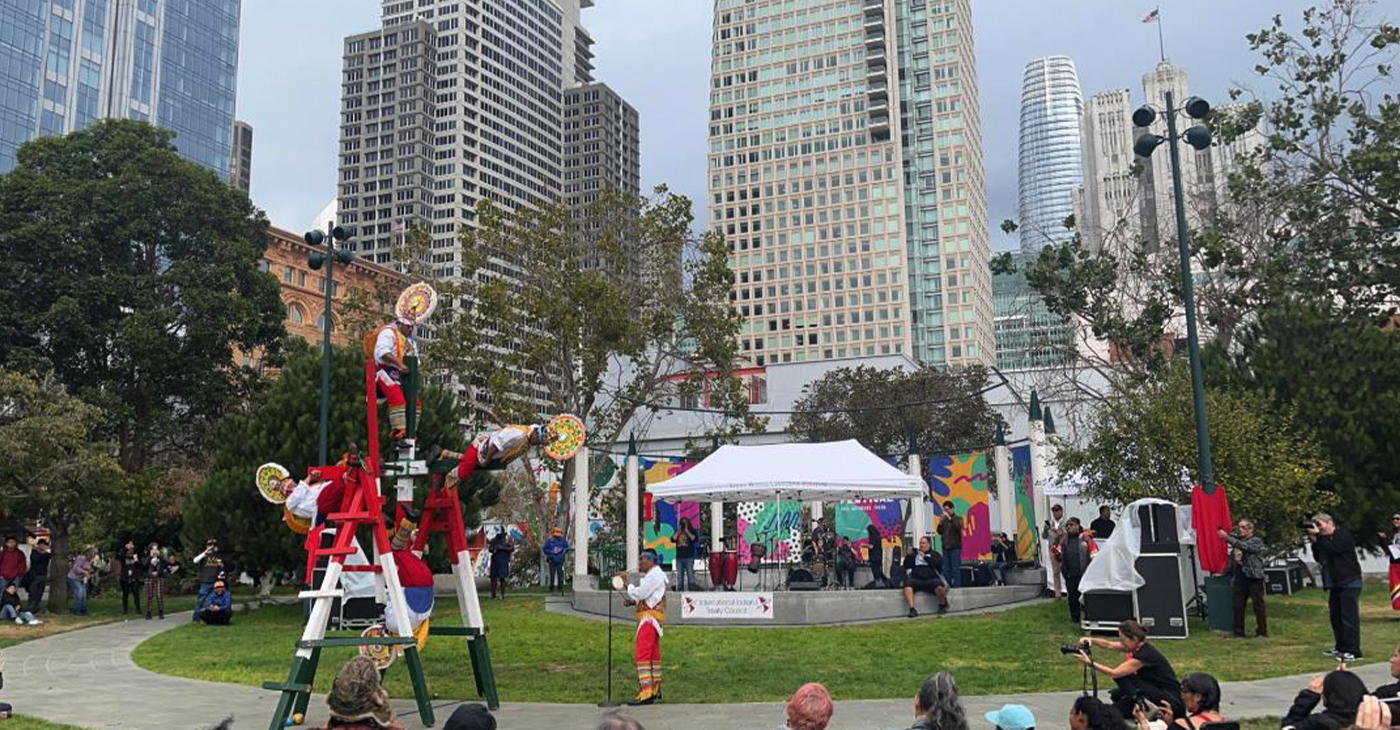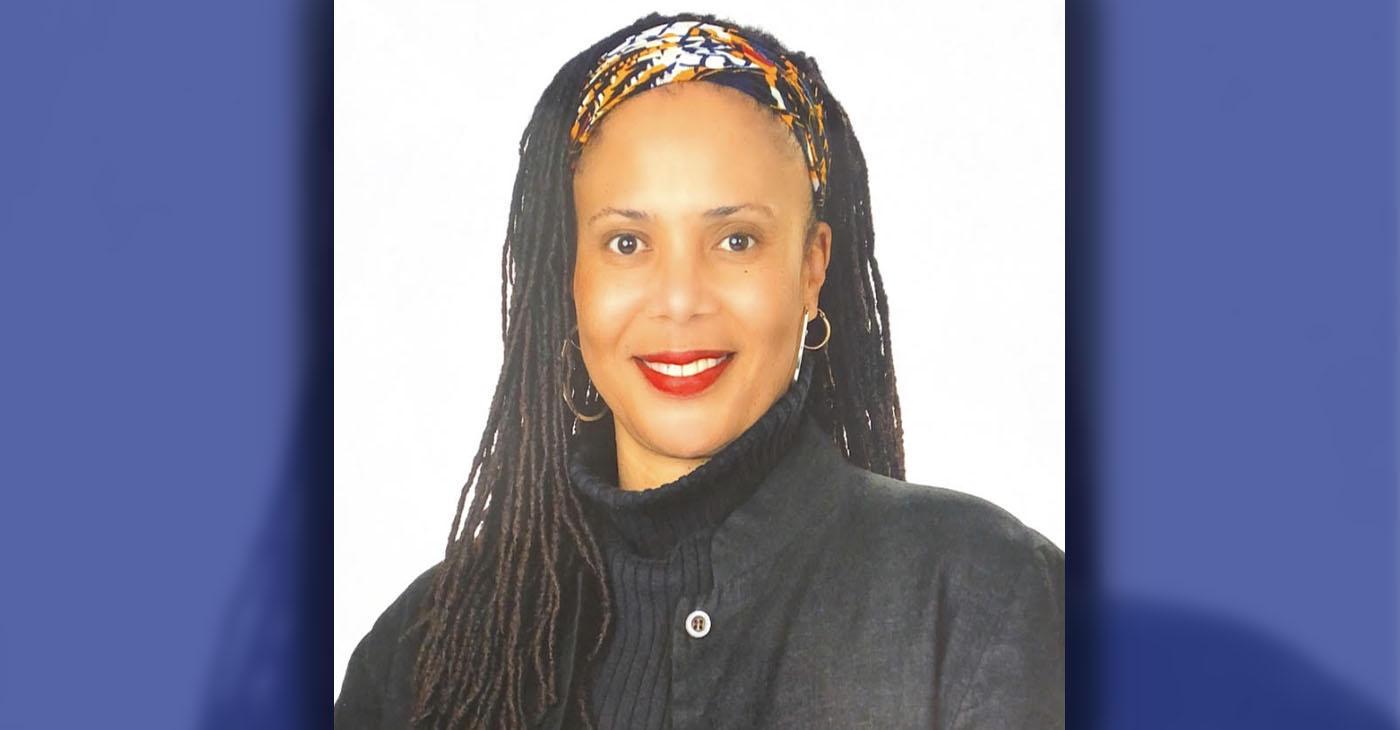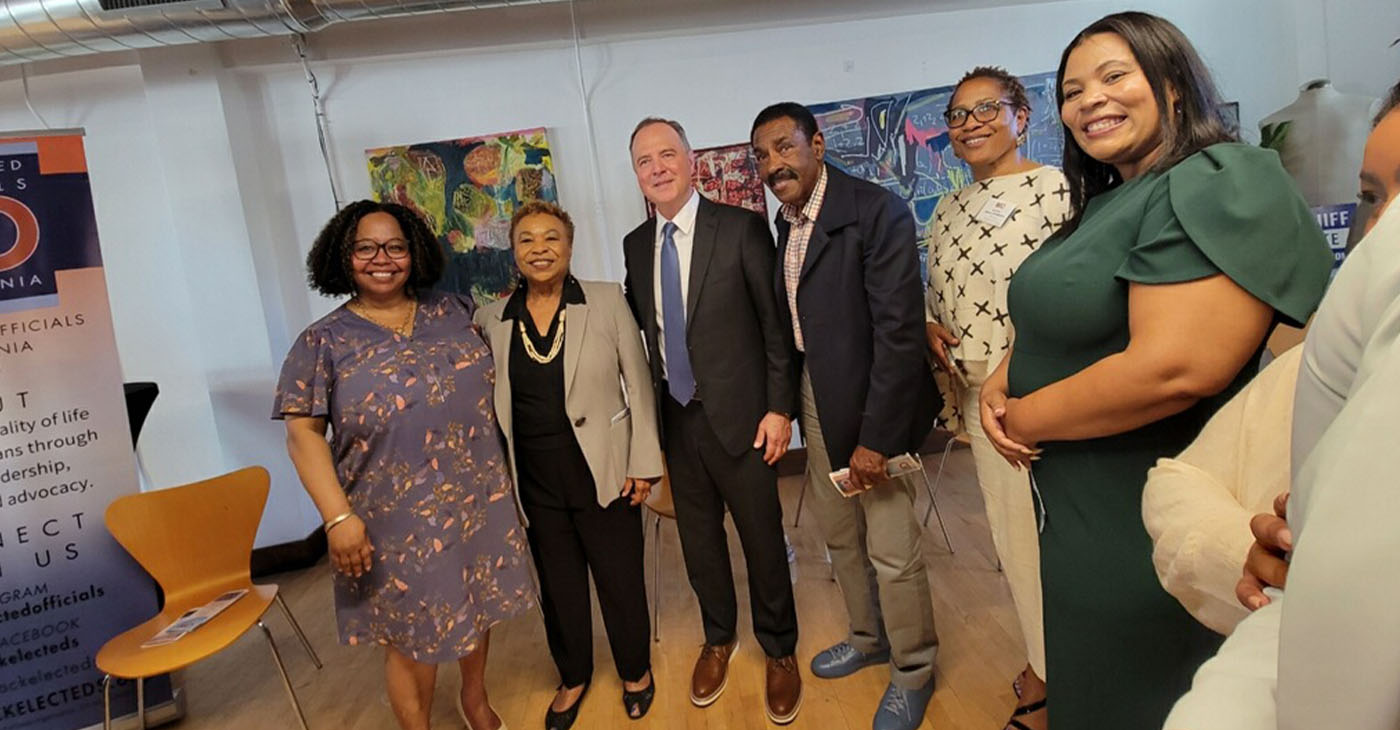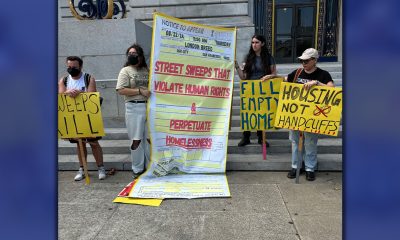Activism
Indigenous Peoples Day Festival at Yerba Buena Gardens in San Francisco
Group leader Vidal Perez has been performing a traditional dance called “Danza de Voladores” and one called “Danza de Wawa” for over 30 years. This dance has been passed down through several generations of men in his family. “We do this dance to celebrate Mother Earth, so that she brings rain, a plentiful harvest and good energy,” Perez said.

By Magaly Muñoz,
Post Staff
On Monday, the Indigenous Peoples Day Festival was held for the fifth consecutive year at the Yerba Buena Gardens in San Francisco. This event was organized in collaboration with the International Indian Treaty Council (IITC) to celebrate and honor the traditions and heritage of Native Americans.
Art exhibits, music performances and vendor stalls were set up at the garden’s public park and cultural space on Monday afternoon with many people stopping by to purchase items or watch the cultural events.
Among the performers was a Mexican native group called Grupo de los Wawas del Centro Ceremonial de Tajín hailing from Veracruz, Mexico. The group belongs to the Totonaco Nation, which is primarily based in east-central Mexico.
Group leader Vidal Perez has been performing a traditional dance called “Danza de Voladores” and one called “Danza de Wawa” for over 30 years. This dance has been passed down through several generations of men in his family.
“We do this dance to celebrate Mother Earth, so that she brings rain, a plentiful harvest and good energy,” Perez said.
He said that they tour all over California, performing for a few weeks before heading back to Mexico to continue expressing their culture through dance. He pointed out that they come to events like this because it allows both Native American and Mexican groups to recognize and celebrate the resilience of communities that strive to preserve their cultural heritage despite enduring a long history of colonization.
“We want people to remember that there are still old customs and cultures to learn about. No matter where we live, the point is to acknowledge where we came from,” Perez said.
Cristina Ibarra, Yerba Buena Gardens Festival’s Strategic Projects Director who is co-organizer for the event, said that this festival is her favorite one to put on each year. She said working with all the vendors and performers has been the best experience, likening it to being in the company of family.
“It’s so beautiful to see all the families, especially the elders and the kids, celebrating their culture,” Ibarra said. “We do probably 150 events every year and this is still one of my favorites.”
Ibarra stated that this year’s festival has seen the biggest turnout since its inception. She affirmed that they’ll continue to host this event in the future as a platform to “uplift Indigenous Peoples voices.”
In 2018, San Francisco made the decision to replace Columbus Day with Indigenous Peoples Day as a means of acknowledging and addressing the historical violence and discrimination faced by Native Americans in the U.S.
Andrea Carmen, the executive director of the IITC since the ’90s, said every city and county on this side of the hemisphere should consider revising this date on their local calendars. Instead of honoring Christopher Columbus, Carmen suggested to celebrate the people impacted by the explorer’s arrival.
“We’re celebrating our survival, the resiliency and strength of our cultures that still exist. We’re honoring our ancestors that sacrificed unbelievable amounts of suffering so that we could have these ways, the dances, the language,” Carmen said.
Carmen observed that it’s been over 500 years since colonization began in the Americas. She stressed that the IITC is committed to preserving their history and teaching it to those who are willing to learn.
She said it’s important for non-Natives to know that there is an ongoing struggle to revitalize languages, reclaim stolen land and preserve tareas that once belonged to Natives. She added that despite the horrors that Natives have endured, they’re still standing.
“We’re still here, our culture is still strong, and the amazing thing to me is that we’re still willing to share it with those very descendants of the ones that carried these things [colonization] out,” Carmen said.
Activism
OPINION: Why the N-Word Should Be Eliminated from Schools: A Call to Educators, Parents and Students
The N-word’s use in schools, intentionally or otherwise, preserves a cycle of racial abuse, degradation, and discrimination which are violations to the dignity of African American students. Its usage perpetuates a legacy of hate and is a dignity violation that makes it a pressing issue for educators to address. Not addressing use of the N word in school contradicts the principles of equity and inclusion that educational institutions strive to uphold.

By Zetha A. Nobles,
The presence and rampant use of the N-word in educational settings poses significant challenges to the social-emotional learning (SEL) and psychological well-being of students and teachers.
The historical and contemporary usage of the N-word carries deep-seated racial connotations and trauma, making it imperative to address its impact in the school environment.
Here’s why the N-word should be eradicated from schools and its detrimental effects on SEL and psychological health.
Historical Context and Significance
The use of the N-word is considered a severe violation of dignity due to its deeply hurtful and dehumanizing nature. The N-word is historically rooted in a long and sordid history of racism, oppression and dehumanization.
It was and is used to dehumanize, degrade, demean and denigrate African American people. Its historical presence is marked by extreme violence and pernicious systemic oppression.
Despite the evolving societal appropriation and the exploitation of the word in hip hop music and other media forms, its controversial use has morphed or mutated into a word now used to signify friendship or endearment.
In schools its use is complex, representing camaraderie, being cool and defiant while consciously and unconsciously dehumanizing African American students and staff.
The N-word has a long history of being used as a tool of oppression and degradation against Black people. It was employed during periods of slavery, segregation, and ongoing racial discrimination to strip individuals of their humanity and reinforce systemic racism.
Its use is a painful reminder of this history and the ongoing struggle against racism. Its impact:
- Dehumanization: When the N-word is used, it reduces Black individuals to a derogatory stereotype, stripping away their identity and worth as human beings. It perpetuates the idea that certain groups are inferior and unworthy of respect and dignity.
- Impact on Self-Worth: Hearing or being called the N-word can have profound psychological and emotional impacts, leading to feelings of shame, anger, and diminished self-worth. It communicates to individuals that they are lesser or undeserving solely because of their race.
- Interpersonal Harm: The use of the N-word in interpersonal interactions conveys disrespect, hostility, and a lack of regard for the feelings and dignity of others. It undermines efforts to build inclusive and respectful relationships.
- Symbol of Structural Injustice: The N-word symbolizes larger societal injustices and inequalities. Its continued use reflects ongoing racial prejudice and discrimination, perpetuating harmful attitudes and behaviors.
Given these reasons, using the N-word is not just a matter of inappropriate language; it represents a significant violation of human dignity and reinforces harmful racial stereotypes and hierarchies. It is crucial to reject and actively challenge the use of this word to promote equality, respect, and dignity for all individuals.
In schools, the word retains its harmful and damaging impact and remains a powerful symbol of racial animosity. The N-word’s use in schools, intentionally or otherwise, preserves a cycle of racial abuse, degradation, and discrimination which are violations to the dignity of African American students. Its usage perpetuates a legacy of hate and is a dignity violation that makes it a pressing issue for educators to address. Not addressing use of the N word in school contradicts the principles of equity and inclusion that educational institutions strive to uphold.
Impact on Social-Emotional Learning (SEL)
Social-emotional learning is crucial for students’ development as it encompasses the skills needed to manage emotions, establish positive relationships, and make responsible decisions. The use of the N-word in schools disrupts this process in several key and critical ways:
- Emotional Trauma: The N-word is a trigger for emotional pain, particularly for African American students and teachers. It can evoke feelings of anger, sadness, shame and humiliation, which hinder the ability to engage fully in the learning process.
- Hostile Learning Environment: A safe and supportive learning environment is essential for effective SEL. The use of the N-word creates a hostile and unsafe atmosphere, leading to increased anxiety, disrespect, and stress among students and teachers.
- Relationship Building: One of the goals of SEL is to foster positive relationships. The use of derogatory language such as the N-word fosters division and mistrust among students and staff.
Psychological Impact on Students and Teachers
The psychological effects of the N-word on students and teachers are profound and far-reaching. For students, especially those of African American descent, the word can lead to feelings of inferiority and exclusion. This not only affects their academic performance but also their self-esteem and mental health. Studies have shown that exposure to racial slurs can increase levels of depression, anxiety, and other mental health issues.
For teachers, addressing the use of the N-word in the classroom is a significant challenge. It places an emotional burden on them, particularly for teachers of color who may feel personally targeted. The stress of managing such situations can lead to burnout and affect their ability to provide a supportive learning environment.
Strategies for Eliminating the N-Word from Schools
To effectively eliminate the N-word from schools, a comprehensive approach is necessary. Here are some strategies:
- Clear Policies and Consequences: Schools must implement and enforce policies that explicitly prohibit the use of the N-word and other derogatory language. Clear consequences for violations should be established and communicated to all members of the school community.
- Cultural Competency Training: Providing cultural competency and anti-racism training for teachers, staff, and students can foster a more inclusive and respectful environment. This training should include the historical context of the N-word and its impact on individuals and communities as well as alternative language.
- Support Systems: Schools should offer culturally congruent support systems, such as counseling and peer support groups, for students and teachers affected by the use of the N-word. These resources can help individuals process their experiences, mitigate psychological harm and co-create a culture of dignity.
- Community Engagement: Engaging the broader school community, including parents and local organizations, in dialogue about the impact of the N-word can reinforce the school’s commitment to creating a respectful and inclusive environment.
In addition to the moral and ethical arguments against the use of the N-word, there are also legal and policy considerations that support its prohibition in schools. Many school districts have anti-bullying and anti-discrimination policies that explicitly prohibit the use of derogatory language, including racial slurs. The use of the N-word in schools can lead to disciplinary actions and legal consequences for both students and staff who violate these policies.
Furthermore, federal laws such as Title VI of the Civil Rights Act of 1964 prohibit discrimination on the basis of race, color, or national origin in programs and activities receiving federal financial assistance. Schools that fail to address the use of the N-word and other forms of racial harassment may be in violation of these laws, potentially resulting in investigations and penalties from the U.S. Department of Education’s Office for Civil Rights.
Addressing the N-word in educational settings is not just about prohibiting a word; it is about dismantling a symbol of hate and fostering an environment where all students and teachers can thrive.
Activism
Oakland Post: Week of September 11 -17, 2024
The printed Weekly Edition of the Oakland Post: Week of September 11 – 17, 2024

To enlarge your view of this issue, use the slider, magnifying glass icon or full page icon in the lower right corner of the browser window. ![]()

Congresswoman Barbara Lee introduced Senatorial Candidate Adam Schiff to the congregants of Allen Temple Baptist Church and to a reception of the California Black Elected Officials organization co-sponsored by BWOPA (Black Women Organized for Political Action). Left to right Wanda Williams, Barbara Lee Adam Schiff, Keith Carson, Lynette Gibson McElhaney, Angela Andrews. Photo by Conway Jones, Jr.
left to right
-

 Activism4 weeks ago
Activism4 weeks agoOakland Post: Week of August 21 – 27, 2024
-

 Antonio Ray Harvey3 weeks ago
Antonio Ray Harvey3 weeks ago“The Nation is Watching”: Cal Legislature Advances Four Reparations Bills
-

 Activism3 weeks ago
Activism3 weeks agoOakland Post: Week of August 28 – September 4, 2024
-

 Arts and Culture3 weeks ago
Arts and Culture3 weeks agoOakland Architect William ‘Bill’ Coburn, 80
-

 California Black Media3 weeks ago
California Black Media3 weeks agoSec. of State Weber Releases Voter Registration Report
-

 Activism4 weeks ago
Activism4 weeks agoA New Coalition Says: ‘Respect Our Vote – No Recalls!’
-

 Business3 weeks ago
Business3 weeks agoGov. Newsom Signs New Laws Strengthening State’s Crackdown on Organized Retail Crimes
-

 Arts and Culture3 weeks ago
Arts and Culture3 weeks agoWorld Arts West Dance Festival Puts Culture and Joy Center Stage



























































